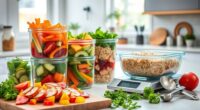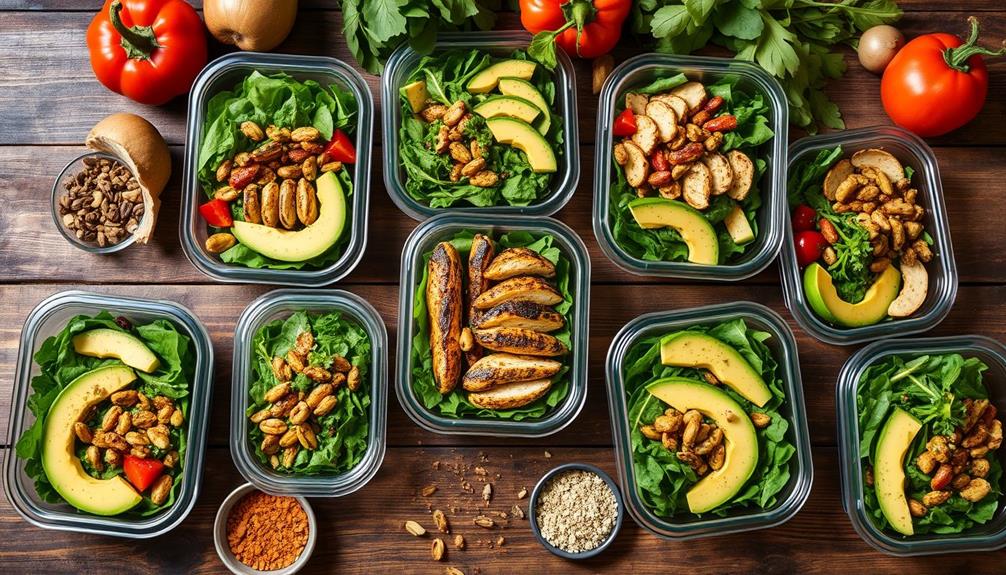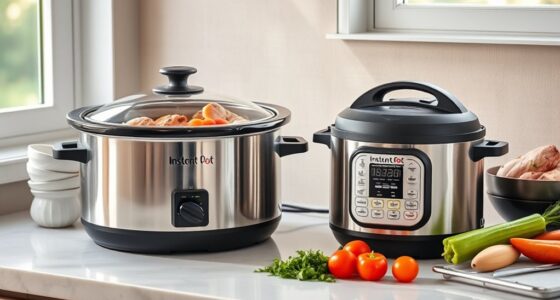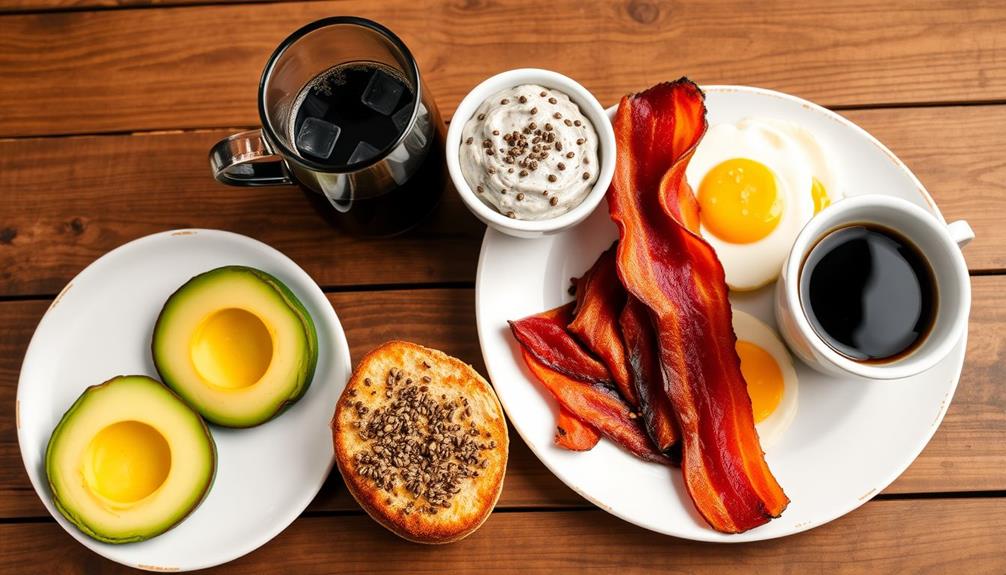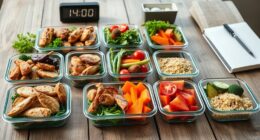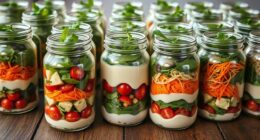To avoid common meal prep mistakes, use proper portion control by measuring servings and storing food in labeled, airtight containers. Keep your fridge below 40°F and freezer at 0°F to guarantee safety and freshness. Organize your space to prevent clutter and waste, and freeze leftovers in individual portions for longer storage. Paying attention to these tips can help you stay on track—stay with us to discover more ways to perfect your meal prep routine.
Key Takeaways
- Measure portions accurately with cups and scales to prevent overeating and reduce food waste.
- Store food in labeled, airtight containers at proper temperatures to maintain freshness and safety.
- Avoid overcrowding the fridge and freezer to ensure good air circulation and prolong shelf life.
- Reheat leftovers thoroughly to steaming hot to prevent foodborne illnesses.
- Organize meal prep areas for easy access, reducing spoilage and encouraging consistent healthy habits.

Meal prep can be a fantastic way to save time and eat healthier, but many people fall into common traps that undermine their efforts. One of the biggest pitfalls is neglecting portion control. If you prepare large portions or don’t measure your servings, you might find yourself overeating or wasting food. To avoid this, invest in a good set of measuring cups and a kitchen scale. Dividing your meals into appropriate portions not only helps with calorie management but also makes it easier to stick to your goals. Over time, you’ll develop an intuitive sense of how much food your body needs, but in the beginning, precise measurements keep you on track.
Portion control is key to successful meal prep and staying on track with your goals.
Another frequent mistake is poor storage techniques. When you don’t store your meals properly, food can spoil quickly or lose its freshness, leading to waste and compromised health. Use airtight containers that are suitable for both refrigerator and freezer storage. Label each container with the date you prepared it so you can consume items within their ideal timeframe. Proper storage also involves organizing your fridge and freezer so that meals are easy to find and access. This prevents you from rummaging through clutter and settling for less healthy options because you’re in a hurry. Keep raw ingredients separate from cooked meals to prevent cross-contamination, and use clear containers so you can see what’s inside without opening them.
Additionally, temperature control is essential. Make sure your fridge is set below 40°F (4°C) and your freezer maintains 0°F (-18°C). This helps preserve the quality of your prepped meals and reduces the risk of foodborne illnesses. When reheating, always check that your food is steaming hot throughout, which guarantees it’s safe to eat and tastes good.
Many first-timers also forget that proper storage techniques extend the life of their meal prep. If you avoid overcrowding your fridge, air can circulate better, keeping everything fresh longer. Using stackable containers maximizes space and helps you organize your meals efficiently. Also, consider freezing individual portions for longer-term use, which prevents leftovers from going bad before you can enjoy them.
Frequently Asked Questions
How Can I Make Meal Prep More Budget-Friendly?
To make meal prep more budget-friendly, you should focus on affordable ingredients like rice, beans, and seasonal vegetables. Planning your meals and buying in bulk can save you money and reduce waste. Bulk shopping allows you to purchase larger quantities at lower prices, making it easier to prepare multiple meals without overspending. Stick to a shopping list to avoid impulse buys and maximize your budget.
What Are Healthy Storage Options for Prepped Meals?
When considering healthy storage options for prepped meals, focus on food preservation and container selection. Use airtight, BPA-free containers to keep meals fresh and prevent contamination. Glass containers are ideal because they’re durable, microwave-safe, and won’t stain or absorb odors. For longer storage, consider vacuum-sealed bags or portioned containers, which help maintain freshness and prevent spoilage. Proper storage guarantees your meals stay nutritious, tasty, and safe to enjoy later.
How Do I Customize Meals for Dietary Restrictions?
To customize meals for dietary restrictions, start by identifying your needs. If you’re gluten-free, use gluten-free swaps like rice or quinoa instead of wheat. For vegan modifications, replace animal products with plant-based options like tofu or beans. Read labels carefully, experiment with herbs and spices for flavor, and plan ahead to make certain your meals meet your restrictions while still being delicious and satisfying.
What’s the Best Way to Reheat Prepped Meals?
When reheating prepped meals, you want to use the right reheating techniques to keep flavors and textures intact. Choose microwave-safe containers to prevent leaks and guarantee even heating. For best results, reheat in short intervals, stirring or flipping the food halfway through. If reheating on the stove, use a covered pan and gentle heat. These container choices and techniques help you enjoy your meals as if freshly made.
How Can I Stay Motivated to Meal Prep Regularly?
Staying motivated to meal prep regularly starts with strong motivation strategies and solid meal planning habits. You can set small, achievable goals to keep yourself inspired, and plan meals you genuinely enjoy to boost enthusiasm. Track your progress and celebrate milestones to maintain momentum. Remember, consistency builds habits, so focus on creating a routine that feels manageable. Over time, these habits will become second nature, making meal prep easier and more enjoyable.
Conclusion
Now that you’re aware of these common meal prep mistakes, you’ll be better equipped to avoid them. Imagine planning your week’s meals and discovering a new favorite recipe you never thought of—you might even find it’s your own twist on a classic. With a little practice, meal prepping becomes second nature, saving you time and stress. So, keep these tips in mind, and enjoy the coincidence of how easy and rewarding meal prep can be when you get it right.

